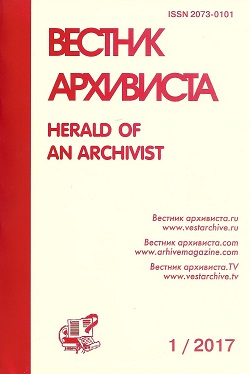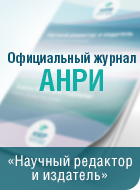"How should we live on": combines of the Leningrad branch of the USSR Art Fund on the eve of the "thaw" at the turn of the 1940s-1950s. Based on materials of the TsGALI SPb



Scientific article
doi 10.28995/2073-0101-2024-1-112-125
For citation
Ananiev Vitaly G. "How should we live on": combines of the Leningrad branch of the USSR Art Fund on the eve of the "thaw" at the turn of the 1940s-1950s. Based on materials of the TsGALI SPb (In Russ). IN: Vestnik Archivista / Herald of an Archivist, 2024, no. 1, pp. 112-125. doi 10.28995/2073-0101-2024-1-112-125
Ananiev Vitaly G., Herzen State Pedagogical University of Russia, Saint-Petersburg, Russian Federation
"How should we live on": combines of the Leningrad branch of the USSR Art Fund on the eve of the "thaw" at the turn of the 1940s-1950s. Based on materials of the TsGALI SPb
Abstract
The article is devoted to the activities of the combines of the Leningrad Branch of the USSR Art Fund in the mid-1950s. The article is based on materials from the Branch's fund deposited in the Central State Archive of Literature and Art of St. Petersburg. The research approach according to which the material is analyzed is connected with the study of everyday life as one of the relevant areas of modern historical science. Researchers advocate the “chamber propaganda program” that operated in the art production of the USSR in the mid- second half of the 20th century. The material of the Leningrad Branch's fund allows us to trace the specific problems faced by the implementation of this plan in practice. Basing on this source, we reveal how reality corrected ideological attitudes. The focus of the article is on the activities of the Painting and Sculpture and Art-design combines of the Branch. The year 1956 was chosen as a chronological marker, as the moment of transition from one political and cultural period to another, from the period of “late Stalinism” to the period of “Thaw”. The archival materials analyzed in the article allow us to draw the following conclusions. Firstly, the personal factor made significant adjustments to the work of the combines. On one hand, there was a struggle against bureaucracy and routine. On the other hand, policy on combating anti-Semitism was publicly announced. Both were supposed to demonstrate a new ideological atmosphere, “correction of the mistakes in the past”. Secondly, an important role in the real participation of combines in the process of forming the living environment of a Soviet citizen was played by the distribution of funding in specific areas of activity. The most artistic trends related to the manufacture of applied art and interior design received the least money. The main funds were spent on direct propaganda and ongoing technical work. Finally, another factor of adjustment was the accepted system of wage payment. It made more profitable work not creative, but routine, related to the repetition of what had already been done earlier. All that complex of factors, of course, left its mark on the implementation of ideological attitudes and corrected the implementation of the "chamber propaganda plan". It seems that this trend of research may be of significant interest both for studying the activities of the enterprises of the USSR art industry, and for the political history of the country and the history of its everyday life. The scientific potential of the relevant archival materials, some of which did not attract the attention of researchers, is extremely great.
Keywords
History of Everyday Life, Soviet Everyday Life, Applied Arts, Enterprises of Decorative Industry, Plan of the Chamber Propaganda, Formation of Environment for Life, the Leningrad Branch of the Art Fund of USSR.
Download the article: ananiev_doi
References
Ainutdinov, A. S. From the history of the Sverdlovsk branch of the USSR Art Fund of the 1940s: the birth of the organization and the beginning of its work (In Russ.). IN: Art of Eurasia. 2021. № 3 (22). pp. 10-21. Electronic resource. Mode of access: https://eurasia-art.ru/art/article/view/743 (date of circulation 30.08.2023).
Blinova, E. K., Sapanja, O. S. Domestic classics as a phenomenon of Leningrad postwar culture (In Russ.). IN: International Journal of Cultural Research. 2022. № 2 (47). pp. 6-17. Electronic resource. Access mode: https://culturalresearch.ru/article/blinova-e-k-sapanzha-o-s-bytovaya-klassika-kak-fenomen-leningradskoj-poslevoennoj-kultury/ (date of circulation 30.08.2023).
Sychenkova, L. A. Image of Jeremiah Isaevich Ioffe in letters and memoirs of relatives and students (In Russ.). IN: Historians about historians. To the anniversary of Prof. G. P. Myagkov. Moscow: Aquilon, 2022. pp. 209-233.
About the authors
Ananiev Vitaly Gennadievitch, Doctor of Cultural Studies, the Herzen State Pedagogical University of Russia, department of art history and pedagogy of arts, professor, Saint-Petersburg, Russian Federation, This e-mail address is being protected from spambots. You need JavaScript enabled to view it
Grant information
The article has been prepared with financial support of the Russian Science Fund (no. 23-18-00419) “The enterprises of the art industry in Leningrad in the 1940–1960s and their role in formation of the living environment”.
The article was received in the editorial office on 5.09.2023, recommended for publication on 20.12.2023.











